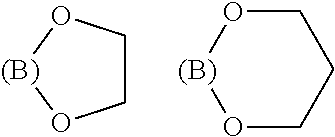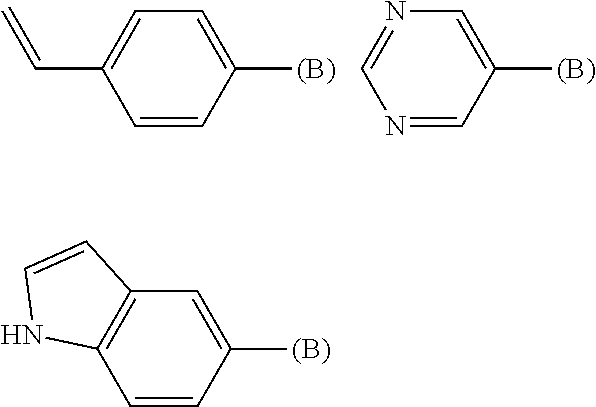Silicon-containing resist underlayer film-forming composition and patterning process
a technology of film-forming composition and film-forming composition, which is applied in the direction of instruments, photomechanical devices, coatings, etc., can solve the problems of deformation of the photoresist film pattern of the upper layer and difficulty in simultaneously forming, and achieve excellent resist pattern, good adhesion, and high precision
- Summary
- Abstract
- Description
- Claims
- Application Information
AI Technical Summary
Benefits of technology
Problems solved by technology
Method used
Image
Examples
examples
[0162]Although Synthesis Examples, Examples, and Comparative Examples will be shown and the present invention will be explained in detail hereafter, the present invention is not restricted to the following Examples. Note that the symbol “%” in the Examples represents a mass %, and the molecular weight measurement was based on GPC.
Synthesis of Base Polymers
synthesis example a-1
[0163]A monomer mixture comprising 5.0 g of phenyl trimethoxy silane (Monomer 100), 17.0 g of methyl trimethoxy silane (Monomer 101), 52.2 g of tetraethoxy silane (Monomer 103), and 7.4 g of ethyl boric acid (Monomer 120) was heated under a nitrogen atmosphere at 100° C. for 3 hours to obtain a boron-containing silane mixture after confirmation of disappearance of ethyl boric acid by GPC. After cooling down to a room temperature, this mixture was gradually added into a mixture comprising 120 g of methanol, 1 g of methanesulfonic acid, and 60 g of deionized water over 30 minutes at room temperature; and then, after completion of the gradual addition, the resulting mixture was kept at 40° C. for 12 hours to carry out the hydrolysis condensation. After the reaction, 100 g of propylene glycol ethyl ether (PGEE) was added thereinto, and then, by-produced alcohols were distilled out under reduced pressure. Then, 1,000 mL of ethyl acetate and 200 g of PGEE were added thereinto to separate ...
synthesis example a-14
[0165]A monomer mixture comprising 9.9 g of phenyl trimethoxy silane (Monomer 100), 20.4 g of methyl trimethoxy silane (Monomer 101), 38.1 g of tetramethoxy silane (Monomer 102) and 7.8 g of 2-thiophene boric acid (Monomer 133) was gradually added into a mixture comprising 120 g of methanol, 1 g of methanesulfonic acid, and 60 g of deionized water over 30 minutes at room temperature; and then, after completion of the gradual addition, the resulting mixture was kept at 40° C. for 12 hours to carry out the hydrolysis condensation. After the reaction, 100 g of propylene glycol ethyl ether (PGEE) was added thereinto, and then, by-produced alcohols were distilled out under reduced pressure. Then, 1,000 mL of ethyl acetate and 200 g of PGEE were added thereinto to separate a water layer. To the remaining organic layer was added 100 mL of ion-exchanged water; and the resulting mixture solution was stirred, settled, and then separated into the layers. This operation was repeated for three t...
PUM
| Property | Measurement | Unit |
|---|---|---|
| boiling point | aaaaa | aaaaa |
| wavelength | aaaaa | aaaaa |
| composition | aaaaa | aaaaa |
Abstract
Description
Claims
Application Information
 Login to View More
Login to View More - R&D
- Intellectual Property
- Life Sciences
- Materials
- Tech Scout
- Unparalleled Data Quality
- Higher Quality Content
- 60% Fewer Hallucinations
Browse by: Latest US Patents, China's latest patents, Technical Efficacy Thesaurus, Application Domain, Technology Topic, Popular Technical Reports.
© 2025 PatSnap. All rights reserved.Legal|Privacy policy|Modern Slavery Act Transparency Statement|Sitemap|About US| Contact US: help@patsnap.com



